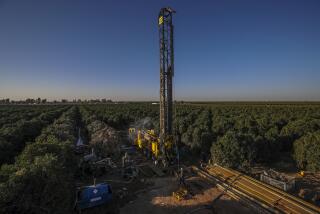Ice Dumped by Greenland’s Glaciers Triples in 10 Years
- Share via
Greenland’s vast glaciers are dumping ice into the ocean three times faster than they did 10 years ago because of increasing temperatures, suggesting that sea level could rise even more quickly than current projections.
The study, published today in the journal Science, found that the glaciers contributed 53 cubic miles of water to the Atlantic Ocean in 2005, resulting in about a 0.02-inch rise in sea level.
“The models we had were not terribly alarming about Greenland,” said Richard Alley, a glaciologist at Penn State University who was not involved in the research. “This paper is a real wake-up call.”
Previous estimates of Greenland’s contribution to sea level rise were based on tracking the thickness of the glaciers to calculate the amount of ice that had melted and flowed into the ocean.
Researchers estimated that in 1996 total ice lost through melting was about 8.3 cubic miles. Just one-quarter cubic mile of ice would supply the water Los Angeles consumes in a year.
Researchers led by Eric Rignot, a glaciologist at the Jet Propulsion Laboratory in La Canada Flintridge, used satellite imagery to measure another source of water: ice cracking off the ends of glaciers to form icebergs.
The imagery showed that Greenland’s southern glaciers are rapidly accelerating their downhill, seaward creep.
Take the Kangerdlugssuaq glacier in the southeast. After creeping along at just more than 3 miles per year, it now moves about 8.7 miles per year.
The increased speed of glacier flow meant that far more water was reaching the ocean.
Greenland’s ice cap is larger than Texas and nearly 2 miles thick in places. The researchers calculated that its glaciers deposited 40 cubic miles of ice into the Atlantic Ocean in 2005, about triple the 13 cubic miles dumped in 1996.
More than 13 cubic miles of ice were shed through melting in 2005, they estimated.
Both forms of ice loss are related to rising temperatures, which in southeast Greenland have climbed 5.4 degrees over the last two decades.
As surface ice melts, the water seeps to the underside of the glacier, where it lubricates the ground and exerts an upward force on the ice, accelerating movement of the ice toward the ocean, Rignot said.
Sea level is rising at 0.12 of an inch a year. That would raise the oceans about a foot by the end of the century.
The Greenland ice cap is the third-leading contributor to the rise. It ranks behind the melting of mountain glaciers and the expansion of ocean water because of higher temperatures.
That 100-year estimate may have to be revised upward to reflect a greater increase from Greenland’s glaciers.
“We don’t know how much more,” said Jason Box, a climatologist at Ohio State University who has modeled melting of Greenland’s ice cap.







